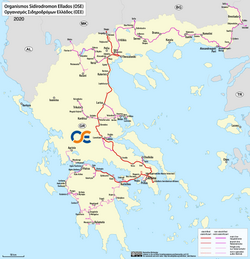This article needs additional citations for verification. (December 2023) |
| Rail transport in Greece | |||||
|---|---|---|---|---|---|
 ETR 470 in the Hellenic Train livery | |||||
| Operation | |||||
| Infrastructure company | Hellenic Railways Organisation, Gaiose | ||||
| Major operators | Hellenic Train[1]
PEARL [1] Rail Cargo Logistics Goldair Grup Feroviar Român Hellas | ||||
| Statistics | |||||
| Ridership | 19,599,000 (2019)[2] | ||||
| Passenger km | 1.252 billion (2019)[2] | ||||
| Freight | 538 million tonne-km | ||||
| System length | |||||
| Total | 2,240 kilometres (1,390 mi)[3] | ||||
| Double track | 524 km (326 mi)[3] | ||||
| Electrified | 532 km (331 mi)[3] | ||||
| Track gauge | |||||
| Main | 1,435 mm (4 ft 8+1⁄2 in) standard gauge | ||||
| 1,000 mm (3 ft 3+3⁄8 in) metre gauge | 787 km (489.0 mi) | ||||
| 750 mm (2 ft 5+1⁄2 in) | 22.3 km (13.9 mi)[4] | ||||
| 600 mm (1 ft 11+5⁄8 in) | 15 km (9.3 mi)[4] | ||||
| Electrification | |||||
| Main | 25 kV 50 Hz | ||||
| Features | |||||
| Longest tunnel | Kallidromo Tunnel 9.6 km (5.97 mi) | ||||
| Highest elevation | Kalogeriko | ||||
| at | 814 metres (2,671 ft) | ||||
| |||||

Rail transport in Greece has a history which began in 1869, with the completion of the then Athens & Piraeus Railway. From the 1880s to the 1920s, the majority of the network was built, reaching its heyday in 1940. From the 1950s onward, the railway system entered a period of decline, culminating in the service cuts of 2011. Ever since the 1990s, the network has been steadily modernized, but still remains smaller than its peak length. The operation of the Greek railway network is split between the Hellenic Railways Organisation (OSE), which owns and maintains the rail infrastructure; GAIAOSE, which owns the building infrastructure (including stations) and the former OSE rolling stock, Hellenic Train; and other private companies that run the trains on the network. Greece is a member of the International Union of Railways (UIC). The UIC Country Code for Greece is 73.

- ^ a b "Σιδηροδρομικές Επιχειρήσεις – ΡΑΣ". 4 August 2023.
- ^ a b "Railway passenger transport statistics" (PDF). Europa EU. 8 December 2019. Retrieved 9 January 2021.
- ^ a b c "Railway Statistics – 2017 Synopsis" (PDF). International Union of Railways, IUC. 2017. Archived from the original (PDF) on 7 April 2019. Retrieved 11 June 2019.
- ^ a b "Σιδηροδρομική Υποδομή" (in Greek). ΟΣΕ. Archived from the original on 2020-06-25. Retrieved 2020-06-22.
